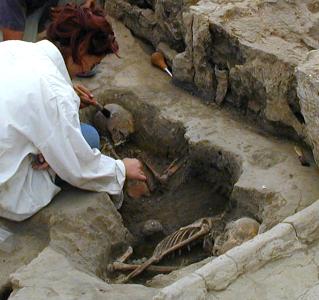Human Bone
Theya Molleson, Peter Andrews, Başak Boz & Lori HagerThe Human Remains team had a quiet season with just three new Neolithic skeletons to excavate and describe, all from the BACH1 area. Accordingly, we concentrated our efforts in getting completely up to date with our descriptions of the human remains, and we are well along the way towards doing this. We were joined this year by Lori Hager, who came as part of the Berkeley team, and we greatly enjoyed working with her. She collaborated mainly with Başak Boz, who was the only permanent member of our team present when the BACH team were on site. |
 Figure 24: Burials in the BACH1 area during excavation |
Theya Molleson concentrated on discussing problems over gender and sexing the Çatalhöyük individuals. This can be done with a fair degree of success for adult individuals, but sexing children is much more difficult. She has also brought her records of ageing and distribution of the human population completely up to date, and so we are in a good position to complete our contribution to the forthcoming volumes.
Başak Boz is also attacking this problem from another point of view. She has been systematically going through the collection to describe the teeth, and she is using techniques more commonly employed on fossil hominids to see if they provide any insights into sexing this human population.
Peter Andrews also took advantage of the quiet year to revise the taphonomic spectrum for all human burials. He devised a taphonomic index based on degree of completeness of human skeletons, breakage of bones, degree of disarticulation of the skeletons, and surface damage to the bones. In addition, he re-examined the human bones from burial 31, which we consider to be the only definite secondary burial (that is consisting of bodies that had been initially exposed on the ground and then buried after partial disarticulation). One cut mark indicating forcible disarticulation of the shoulder joint is present on one of these bodies. He also looked at the cut marks on the two headless skeletons, where the bodies had been buried whole but the heads removed some time after burial.